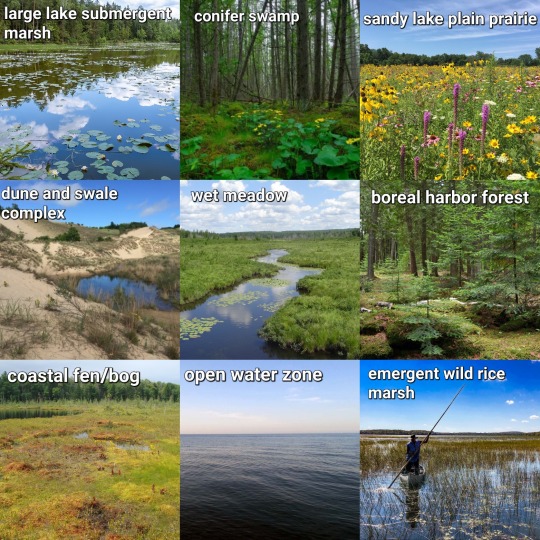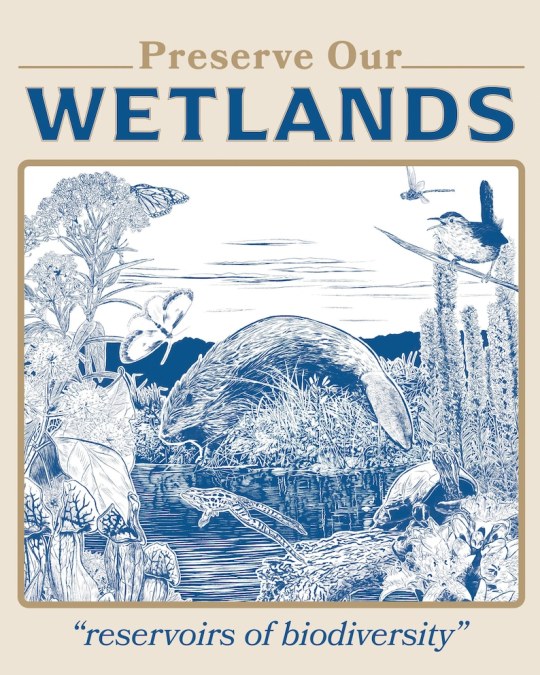#wetland ecology
Photo

TYPES OF WETLANDS:
Did you know there are different kinds of wetlands? In addition to the tidal salt marshes you might think of, there are also swamps, bogs, fens, and freshwater marshes!
Types of wetlands:
Marshes
Marshes are defined as wetlands frequently or continually inundated with water, characterized by emergent soft-stemmed vegetation adapted to saturated soil conditions. There are tidal salt marshes or freshwater marshes.
Swamps
A swamp is any wetland dominated by woody plants.
Bogs
Bogs are characterized by spongy peat deposits, acidic waters and a floor covered by a thick carpet of sphagnum moss.
Fens
Fens are peat-forming wetlands that receive nutrients from sources other than precipitation: usually from upslope sources through drainage from surrounding mineral soils and from groundwater movement. Fens differ from bogs because they are less acidic and have higher nutrient levels.
Learn more about wetlands:
https://www.epa.gov/wetlands/classification-and-types-wetlands
2K notes
·
View notes
Text

sphagnum moss
#moss#sphagnum moss#forest#spruce#environment#nature#photography#north#trees#naturist#wetlands#wetland#wetland ecology#sphagnum#conservation#birch#birch trees#camping#outdoors
113 notes
·
View notes
Text
Perks the job: Froggy friends everywhere!

#cat chat#hyla cinerea#we had to count every blade of the Flowering Rush#half way through we called it quits at 9am bc it was blazing hot#wetland ecology#frogs
3 notes
·
View notes
Text

2 notes
·
View notes
Text
vibrating and shaking like a poorly socialized chihuahua because someone wants to do more work in my wetland!!!!! it's OUR wetland now, comrade!!
#shes gonna do such a good job!!#this is a literal daydream come true#i get to help her figure this out! and shes excited to work on it! and she wont be going in blind like i did#and so will be able to go above and beyond my work!!#thats science babey!!!!!!!#personal#field work#field notes#wetland ecology#field ecology
2 notes
·
View notes
Text
He now knew more than Niobe did about the wetlands, and she was fascinated by the lore he had acquired.
"Incarnations of Immortality: With a Tangled Skein" - Piers Anthony
#book quote#incarnations of immortality#with a tangled skein#piers anthony#college education#wetland ecology#wetlands#fascinated#lore
0 notes
Text
"When considering the great victories of America’s conservationists, we tend to think of the sights and landscapes emblematic of the West, but there’s also a rich history of acknowledging the value of the wetlands of America’s south.
These include such vibrant ecosystems as the Everglades, the Great Dismal Swamp, the floodplains of the Congaree River, and “America’s Amazon” also known as the “Land Between the Rivers”—recently preserved forever thanks to generous donors and work by the Nature Conservancy (TNC).
With what the TNC described as an “unprecedented gift,” 8,000 acres of pristine wetlands where the Alabama and Tombigbee Rivers join, known as the Mobile Delta, were purchased for the purpose of conservation for $15 million. The owners chose to sell to TNC rather than to the timber industry which planned to log in the location.
“This is one of the most important conservation victories that we’ve ever been a part of,” said Mitch Reid, state director for The Nature Conservancy in Alabama.
The area is filled with oxbow lakes, creeks, and swamps alongside the rivers, and they’re home to so many species that it ranks as one of the most biodiverse ecosystems on Earth, such that Reid often jokes that while it has rightfully earned the moniker “America’s Amazon” the Amazon should seriously consider using the moniker “South America’s Mobile.”
“This tract represents the largest remaining block of land that we can protect in the Mobile-Tensaw Delta. First and foremost, TNC is doing this work for our fellow Alabamians who rightly pride themselves on their relationship with the outdoors,” said Reid, who told Advance Local that it can connect with other protected lands to the north, in an area called the Red Hills.
“Conservation lands in the Delta positions it as an anchor in a corridor of protected lands stretching from the Gulf of Mexico to the Appalachian Mountains and has long been a priority in TNC’s ongoing efforts to establish resilient and connected landscapes across the region.”
At the moment, no management plan has been sketched out, but TNC believes it must allow the public to use it for recreation as much as possible.
The money for the purchase was provided by a government grant and a generous, anonymous donor, along with $5.2 million from the Holdfast Collective—the conservation funding body of Patagonia outfitters."
youtube
Video via Mobile Bay National Estuary Program, August 7, 2020
Article via Good News Network, February 14, 2024
#united states#alabama#estuary#wetlands#swamp#river#environment#environmental issues#conservation#video#biodiversity#american south#ecosystems#ecology#conservation news#wildlife conservation#ecosystem#conservation efforts#good news#hope#forest#swampco#re#Youtube
2K notes
·
View notes
Text
Plain Language Summary
Methane is a potent greenhouse gas and understanding what controls methane production from microbes to plant communities can improve our estimates of wetland fluxes and global methane budgets. We propose characterizing methane dynamics in herbaceous wetlands at the scale of plant patches as patches integrate multiple local properties, are generally discrete, and relatively easy to map and measure. To characterize common wetland patch types, we investigate patterns of dissolved methane, soil biogeochemistry, and plant properties in 4 vegetated (submerged vegetation, forb, grass, and sedge) and 1 unvegetated wetland patch types in a temperate, freshwater, herbaceous wetland.
Here's the (open access) paper: Sharp et al. (2024)
Submitter comment: "I'm crying laughing about this 'plain language' summary. It's like that one xckd comic [Ed.: link here]:
“‘wetland dynamics are second nature to us biogeochemists so it's easy to forget that the average person probably only knows fluxes, a few types of wetlands, and plant patches.’
“‘And forbs.’
“‘Of course.’”
424 notes
·
View notes
Text

#poll#great lakes#ecosystems#ecology#marsh#lake#lakeposting#freshwater#wetlands#fen#bog#cattail#wild rice#forest#boreal#boreal forest#prairie#dune#dunes#dune and swale#estuary#delta#wet meadow#swamp
3K notes
·
View notes
Text

Preserve Our Wetlands - Digital Print by QuerkusCreative
191 notes
·
View notes
Text



A Shoo-in Shoebill Stork
The shoebill stork, also known as the whalebill stork or Balaeniceps rex is in fact not a stork at all, but a long-legged wading bird belonging to the family Pelecaniformes. This species can be found in the central African tropics, from southern Sudan to northern Tanzania. Within this range, they mainly inhabit freshwater swamps and dense marshes, particularly those with deep water large reed beds.
Balaeniceps rex is often referred to as a dinosaur among birds due to its fearsome appearance. The average individual stands 1.1-1.4 m (3.6-4.5 ft) tall and has a wingspan of 2.3 to 2.6 m (7.5 to 8.5 in). However, adults are quite light, weighing only 4 to 7 kg (8.8 to 15.4 lb). Males tend to be larger than females, but otherwise the two sexes look identical. Adults have dark grey plumage with a lighter belly and darker wings. Their most striking feature is their beak, which is extremely large and can be said to resemble a wooden show (hence the name).
The shoebill's beak is very useful for catching its primary prey: fish. B. rex consumes a variety of species, including lungfish, catfish, and tilapia, as well as non-fish items like water snakes, frogs, turtles, mollusks, and even young crocodiles. Shoebills typically stalk their prey, or stand perfectly still and wait for their prey to come to them, before quickly snatching it up and decapitating it with the sharp edges of their beaks. Because of their large size and strong bills, adults are seldom prey for other animals, and they defend their nests fiercely from predators like snakes and other birds.
Outside of the breeding season-- and even during it-- shoebills are extremely territorial. Not only do they chase potential predators away from their nests, both males and females will fiercely defend their territory from other shoebills.
Breeding begins in the dry season, typically in in May, and lasts until about October. Once a male and female form a pair, they remain together for the duration of the mating season. They build a nest from floating vegetation, and 1-3 eggs are cared for by both parents; in addition to being incubated for warmth, one parent may also occasionally pour a beak-full of water over the eggs to keep them cool during the hot summer day. The eggs hatch about 30 days after being laid, and young are fed continuously-- though usually only one chick survives to adulthood. At 125 days old they become fully independent and leave to establish their own territories. The average individual can live up to 35 years in the wild.
Conservation status: The IUCN lists the whalebill stork as Vulnerable. Current wild population estimates sit at about 5,000-8,000 individuals. Primary threats include poaching for the zoo trade and consumption, habitat destruction, and pollution.
If you like what I do, consider leaving a tip or buying me a kofi!
Photos
Santiago Caballero Carrera
George Amato
Mana Meadows
#shoebill stork#Pelecaniformes#Balaenicipitidae#wading birds#birds#wetlands#wetland birds#freshwater fauna#freshwater birds#africa#central africa#animal facts#biology#zoology#ecology
158 notes
·
View notes
Text
I love you bog i love you fen i love you swamp i love you estuaries i love you sphagum moss i love you peat i love you carbon and methane sequestration i love you boreal lowlands I love you wetlands I love you landscapes carved by receding glaciers
#i’m obsessed#ecology#bog#fen#wetlands#if swamps have one hundred fans I am all of them#if swamps have no fans I’m dead etc etc
599 notes
·
View notes
Text
Beavers are a keystone species that can help control areas (like California) that are affected by droughts, wildfires and floods by creating wetlands
#saw an article in the toronto star about this and wanted to post about it!#beavers#ecology#California#wetlands#conservation#biology#biodiversity
157 notes
·
View notes
Text
I start my new job tomorrow! Feels like my biology degree is finally paying off. Which is amazing because I went into it expecting no return.
#cat chat#I'll be working with the Corps of Engineers ERDC studying giant salvinia which is invasive#wetland ecology#my boss wont even be there for two weeks lol
5 notes
·
View notes

